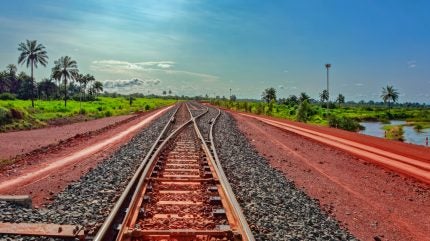
The global rail transportation market was valued at US$ 724,180 million in 2022 and, by 2029, is projected to reach US$ 943,820 million. Driving this rapid growth are several factors, including an increased focus on the implementation of high-speed trains and a push to reduce carbon emissions in the sector.
However, the key to this evolution will be the steady adoption of digital transformation, a shift that will facilitate the scaling of infrastructure accordingly. Rail networks of the future need an ecosystem of integrated, seamless communications, built upon a network robust enough to support high data traffic, and flexible and secure enough to navigate updates or breaches.
Leading the way are various Internet of Things (IoT) related technologies such as 5G, AI, and cloud, each of which plays a pivotal role in the digitalisation of logistics and transport while providing enhancements to the safety, connectivity, and sustainability of networks. Market analysts anticipate that the global IoT in transportation market will reach USD 372.7 billion by 2028, exhibiting a CAGR of 19.8% during the forecast period of 2023-2028.
But the path toward digitalisation of the transportation sector will not be without its challenges. The rising cost of labour, high fuel prices, complex supply chains, maintenance expenses, regulatory compliance, and ESG (environmental, sustainability, and governance) demands, must all be contended with. A distinct advantage to navigating these hurdles, however, will be held by the rail companies that can adapt quickly to technological shifts and embrace a unified digital strategy.
Smart networks
According to Jackie Miao, Director of Transportation Huawei APAC Enterprise: “Today, most railways still operate using narrow bandwidth wireless networks for dispatch and rail signalling such as GSM-R or Tetra Radio and these technologies are out of date and cannot support smart rail requirements.” What’s required is innovative optical technology that enables the seamless upgrade of this infrastructure.
Huawei has been engaged with the railway industry for nearly 30 years. Helping railways build smart systems that cover applications, hubs, connectivity, and interaction, Huawei’s unifying solutions enable rail operators to collect and analyse comprehensive railway data, which can be used to drive innovation and optimise every aspect of operations.
Its offering includes the Future Railway Mobile Communication System (FRMCS) which enables functions such as train-to-ground wireless services for train control and dispatch, railway operations and maintenance (O&M), and railway IoT.
“Huawei has always been dedicated to finding the right technology for the right scenario and boosting productivity with technologies,” said Jackey Wang, vice president of Huawei’s Smart Transportation BU. “Together with industry partners, we are building a more secure, convenient, intelligent, and eco-friendly transportation industry through technological innovation.”
Huawei has helped many railway industry operators achieve digitalisation. During Asia Pacific Rail 2024, Huawei hosted the yearly Huawei Global Rail Summit with the theme of ‘Leading Infrastructure to Accelerate Transportation Intelligence.’ At the Summit, the executives from Malaysia Rail Industry Corporation, MTR Corporation Limited and Malaysia Rail Link shared their success stories.
So far, Huawei’s products and solutions have been deployed on more than 150,000 kilometres of railways around the world.
Case study: rail transformation in Africa
As international interest in its rich mineral deposits has grown alongside the need to better serve its urban populations, Africa has begun to emerge as a dynamic railway market. But this hasn’t always been the case, not least because the continent’s network involves collaboration between multiple countries and stakeholders all operating to varying standards.
“Most urgent on the agenda for Africa’s rail network is a unified standard for the region,” says Li Mingqun, the managing director of Huawei Sub-Saharan Africa Transportation Business. “Africa needs to establish a unified market to bring together market operators and make communications seamless. But across multiple countries, it can be hard to collaborate to the same standard.
“From an ICT perspective, Huawei’s FRMCS solution helps to build the region’s operation communication system which enables its network to move smoothly through one country to another.”
Last year, Huawei and the Southern African Railways Association (SARA) signed a Memorandum of Understanding (MOU) to create a non-exclusive framework of cooperation for the transformation of the Southern African Development Community (SADC) region’s railway transport and corridor logistics. The aim is to enable seamless, efficient, and cost-effective railway corridor services on all SARA Corridors.
Key to the success of the project is delivering next-generation communication standards. As part of the agreement, Huawei is recommending regional ICT railway standards, upgrading train control technology, and providing stakeholders with access to a shared database to improve efficiencies and reduce disruptions along the supply chain. It will see improvements to SARA’s overall operational efficiencies through unified telecommand ICT integration; measures which will help to enhance the system’s security and provide real-time tracking of freight and cargo.
Crucial to this will be the replacement of its current GSM-R standard, which at a bandwidth of 9.6kbps, is not large enough to meet the network’s requirements. What’s more, the GSM-R’s ecosystem is reaching the end of its life cycle on a global scale. According to Mingqun: “Most legacy systems are GSM-R. Unfortunately, this system is dying. This means that in another five or so years, it will not be cost-effective to continue with GSM-R.”
SARA will replace this legacy system with Huawei’s FRMCS, which will prove essential to the standardisation of technology and communication across the region’s railways and allow for a faster shift to a more digitalised and intelligent network.
Says Mingqun: “One tech makes one rail, and one rail makes one Africa. Huawei has been in Africa for 25 years and its ongoing contribution to ICT technology for Africa underpins the pivotal role of ICT infrastructure in the regional, and indeed, global, railway industry.”
For more information on how innovative digital infrastructure enables intelligent transformation across industries, click here.

